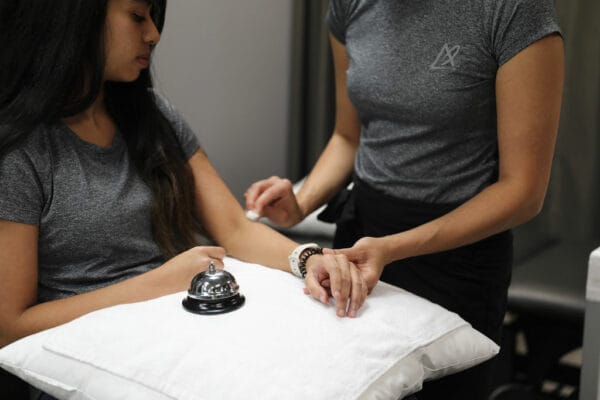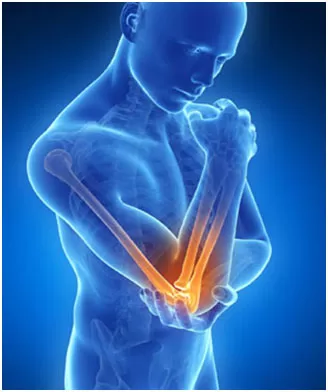What is Lateral Epicondylitis?
Lateral Epicondylitis also known as “Tennis Elbow” is the most common overuse injury in the elbow. This injury involves partial or complete tears in the extensor tendons of the forearm muscles causing pain on the lateral (outside) elbow on a region known as the lateral epicondyle.
Anatomy
The elbow joint is made up of three bones: the humerus (upper arm bone), the radius and ulna (two bones in the forearm). On the distal end of the humerus there are two epicondyles, one lateral (on the outside) and one medial (on the inside).
The muscles that extend our wrist are attached to the lateral epicondyle by tendons. These muscles include extensor carpi radialisbrevis (ECRB) extensor carpi radialislongus (ECRL), extensor digitorum and extensor carpi ulnaris. The tears, and subsequent pain, from lateral epicondylitis usually occurs along these tendons. Most commonly the extensor carpi radialisbrevis (ECRB) is injured, but this injury can occur in any of the other muscles mentioned.

Causes
Lateral epicondylitis usually occurs due to overuse or repetitive movements of the extensor muscles of the forearm. Such an issue can occur due to:
- An over reliance of the extensor muscles because of poor conditioning or injury in the shoulder or upper arm muscles.
- Occupations and nonathletic activities requiring repetitive upper extremity activities and particularly those involving computer use, heavy lifting, forceful forearm pronation (palm face down) and supination (palm face up), and repetitive vibration.
- Improper technique or positioning with equipment i.e. tennis racket.
Risk Factors
While aging is the strongest risk factor associated with lateral epicondylitis, numerous other risk factors have been identified:
-work/non-work related activities requiring repetitive movements,
-training errors,
-misalignments,
-flexibility problems,
-poor circulation,
-strength deficits or a muscle imbalance,
-psychological factors.
Symptoms
- Gradual increase in pain on the lateral aspect of the elbow.
- Weakness in grip strength.
- Worse pain with activities that involve extension of the wrist, e.g. backhand tennis stroke, repetitive use of a screwdriver, or lifting heavy objects.
- In more severe cases, pain can occur with such simple activities as holding a coffee cup or turning a door knob.
Physiotherapy Treatment
There are different types of therapies to treat lateral epicondylitis, all with the same aim: reduce pain, improve function and strengthen the affected muscle. Some of the ways a physiotherapist can help manage and treat your lateral epicondylitis includes:
-Joint Mobilization
– Deep Transverse Frictions
– Modalities – Ultrasound, Electrotherapy, Cyrotherapy, Laser, Extracorporeal Shockwave Therapy
– Orthoses (Bracing)
Exercise Therapy
Stretching – The research and literature shows that strengthening and STRETCHING exercises are the most important components of exercise programmes, for the reason that tendons should not only be strong but also flexible.
Eccentric Exercises
Research has also shown that lateral epicondyitis has shown improvement following treatment utilizing isokinetic eccentric exercise. A great exercise which utilizes this principle is the FlexBar eccentric exercise which has been clinically proven to be effective in providing in improving function with lateral epicondylitis.
Click HERE to book an appointment with a physiotherapist at one of our eight locations.
- Physiotherapy Etobicoke – Triangle Physiotherapy Etobicoke
- Oakville Physiotherapy Clinic – Triangle Physiotherapy Oakville
- Physiotherapy North York – Triangle Physiotherapy North York
- Mississauga Physiotherapy Clinics – Triangle Physiotherapy Mississauga
- Downtown Physiotherapy Clinics – Triangle Physiotherapy King West
- Uptown Physiotherapy Clinics – Triangle Physiotherapy Lawrence Park
- Physiotherapy Clinic Downtown Toronto – Triangle Physiotherapy Queens Quay
- Physiotherapy Clinics Mississauga – Triangle Physiotherapy Erin Mills
Physiotherapy is essential in treating tennis elbow by reducing pain, improving strength, and restoring arm function. If you’re looking for professional physiotherapy services for tennis elbow, there are clinics in physiotherapy Etobicoke, Oakville, North York, Toronto, Lawrence Park, Queens Quay, Erin Mills, Mississauga, and Liberty Village. These clinics offer expert care and personalized treatment plans to help you recover and regain full use of your arm.


